The response of Japan Water Agency to Typhoon No. 19
1 November, 2019
Typhoon No. 19, which formed on October 6, 2019, landed on the Izu Peninsula, Shizuoka Prefecture, around 7:00 pm on October 12, and crossed the Kanto area to pass from the vicinity of Fukushima Prefecture to the Pacific Ocean. Due to this typhoon, a record-breaking rainfall was observed in all over Japan. Under such circumstances, the dams managed by Japan Water Agency (JWA) carried out disaster prevention operations to prospected floods in the downstream areas of the dam. Also, based on a request from local governments that were hit by the typhoon, JWA provided disaster support for drainage work by dispatching a drainage pump truck owned by JWA.
*Disaster prevention operation is to be executed by a dam, which reduces the amount of water flowing downstream from the dam by temporarily storing a part of the flowing water into the dam during heavy rains, by which the water level of the downstream river lowers.
Flood control by dams
Arakawa Dam Integrated Operation and Maintenance Office (Urayama Dam/ Takizawa Dam)
Urayama Dam and Takizawa Dam managed by the above office, as these were in the non-flood season since October 1, had higher water levels than their preparatory water levels to store water for possible floods. Under such conditions of water storage, large and powerful Typhoon No. 19 was expected to hit and cause large-scale floods. The reservoir level was lowered below the pre-flood storage level, so the flood control capacity was secured, and the same disaster prevention operation as is done in the flood season was performed.
At Urayama Dam, toward the flood, which was the largest-ever inflow since the start of its management, when the maximum amount of water flowing into the dam was approx. 423 m³/s, approx. 303 m³/s of water was stored in the reservoir. The water level at the Hanamido observation point located downstream of the dam was successfully reduced by approx. 0.9m.
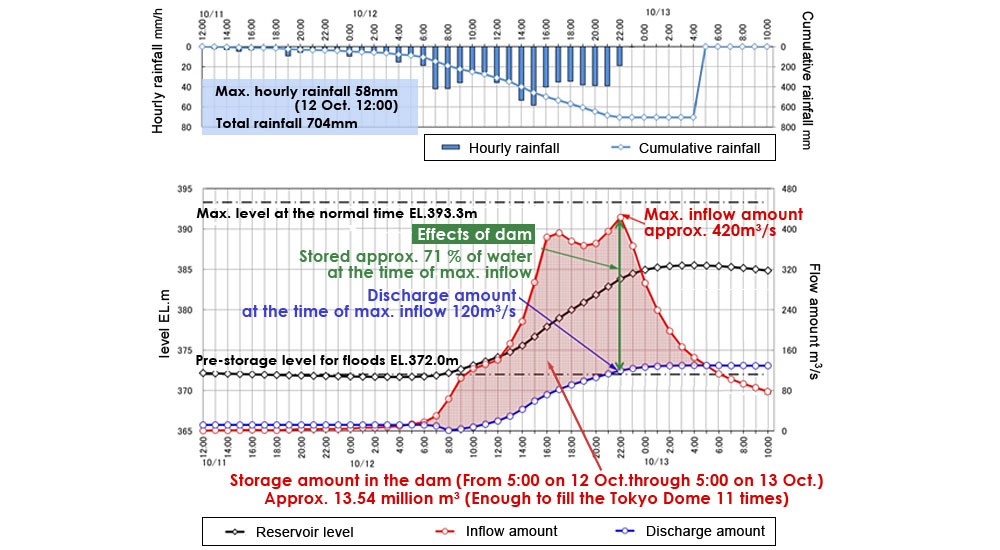
Disaster prevention operation at Urayama Dam (Typhoon No. 19)
*The figures in the chart are preliminary, so that they may be changed. (The graph data in the chart indicate the values hourly, not on minute basis.)
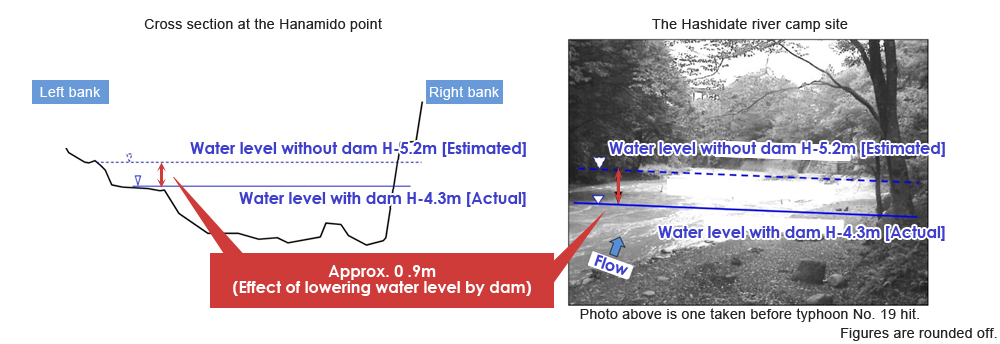
Effects of lowering the water level in the downstream river– at the Hanmido point in the Urayama Riverr
Similarly, at Takizawa Dam, as the maximum amount of inflow was a record high since the start of its management, the maximum amount of water flowing into the dam was approx. 700m³/s, then approx.532m³/s of water was stored in the reservoir. The water level at the Taihei Bridge observation point located downstream of the dam was successfully reduced by approx. 2.5 m.
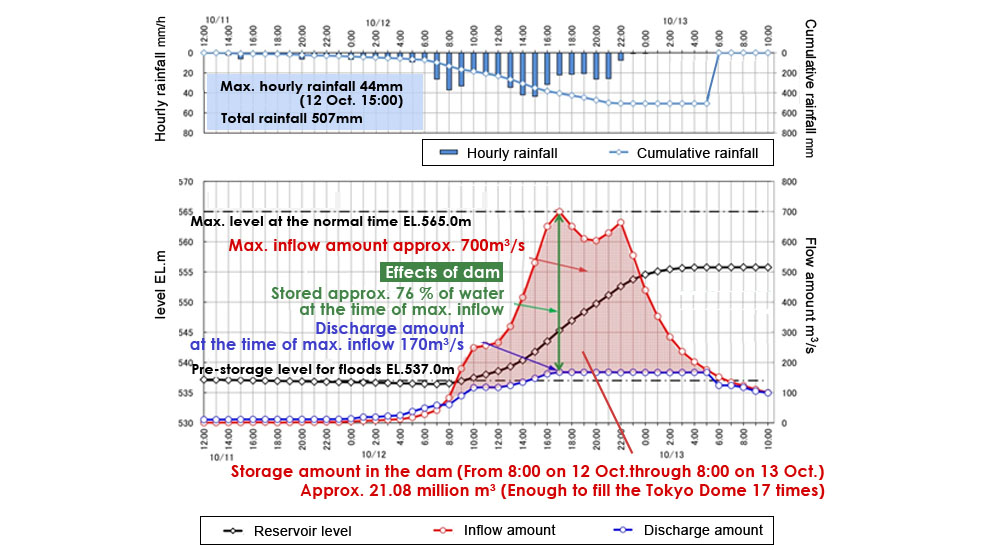
Disaster prevention operation (Typhoon No.19) in Takisawa Dam

Effects of lowering the water level in the downstream river – at the Taiheibashi point in the Nakatsugawa River (Otaki, Chichibu City)
Shimokubo Dam
Under the influence of Typhoon No.19, rainfall of 513mm in total was recorded as the largest one in the catchment area of Shimokubo Dam since the management of the dam started in 1969. The water of the river began to increase as it began raining, and then it recorded an inflow of 1,840m³/s around 6:00 pm on October 12. This amount of inflow was also the largest ever since the dam started its management.
The pre-discharge operation started to secure the flood control capacity at 8:00 pm on October 11, which reduced the water flowing downstream from the dam by storing a part of the flood into the reservoir. The disaster prevention operation was here implemented to reduce the water level of the river downstream. Besides, because the scale of the flood was beyond one planned initially, and the maximum water level at the time of flooding was expected to be higher, the possibility to carry out the disaster prevention operation for extraordinary floods was getting higher before around 1:00 am on October 13. However, such operation was evaded as the inflow was decreasing more than predicted. The quantity of water that was accumulated by the operation in the dam reservoir reached approx. 31.41 million m³.
The amount of discharge from the dam during the disaster prevention operation, when a maximum inflow of 1,840 m³/s was recorded at 6:00 pm on October 12, was 795 m³/s, and controlled a flood of approx. 1,045 m³/s. This disaster prevention operation is estimated to have reduced the water level by approx. 1.8m at the point of Wakaizumi approx. 9.5km downstream of the dam.
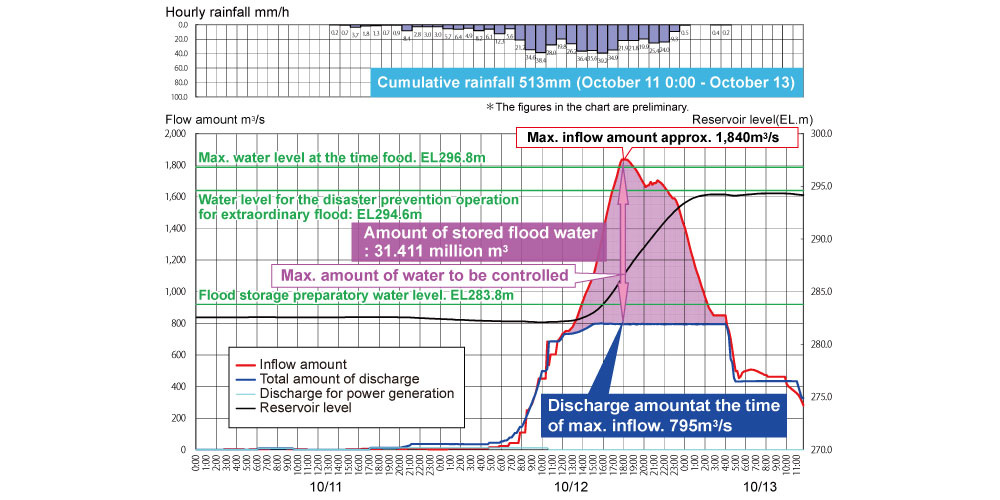
Disaster prevention operation in Shimokubo dam(Typhoon No.19)
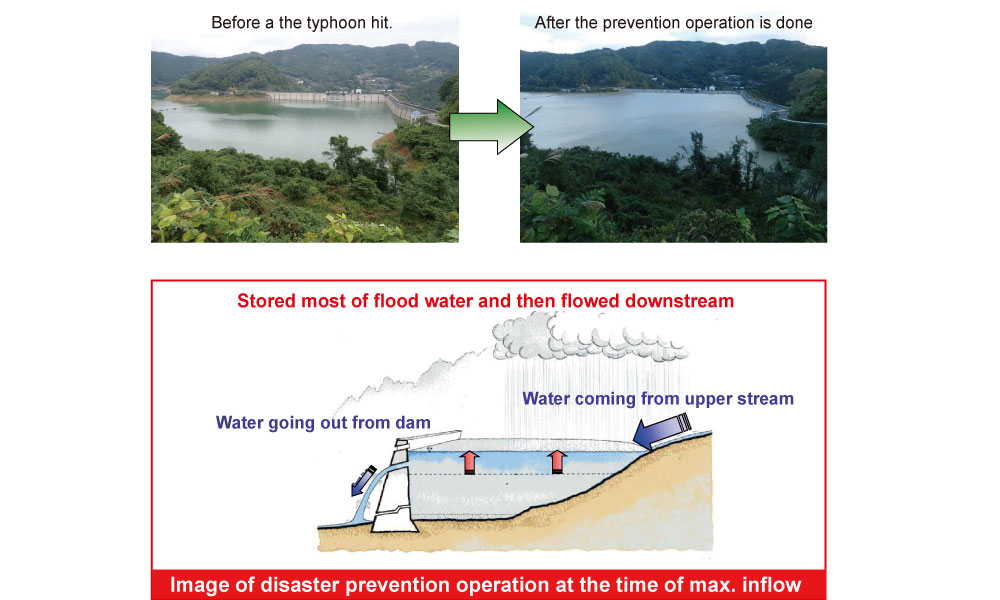
Disaster prevention operation in Shimokubo Dam
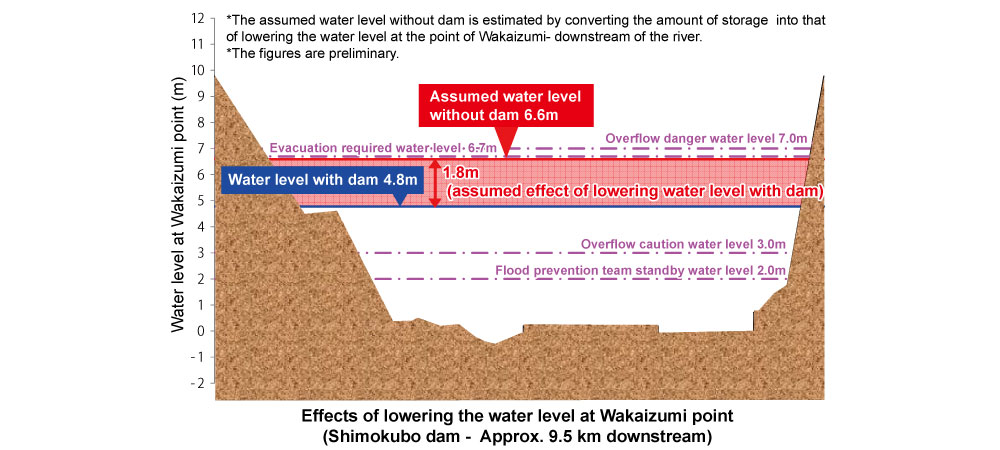
Effects of lowering the water level in the downstream river (Estimated value at the Wakaizumi point)
Kusaki Dam
Kusaki Dam implemented disaster prevention operation for the heavy rain caused by Typhoon No. 19, and part of the flood was stored in the dam to reduce the water level in the downstream river.
Storage started to aim at the full water level (EL.454.0m) in early October. As the typhoon was being approached, pre-discharge was executed at 10:00 am on October 11. Then the reservoir level was lowered to the flood season control level (EL.440.6m) to secure a flood control capacity of 20 million m³. Later, under the direction of the Ministry of Land, Infrastructure, Transport, and Tourism, the water storage level was further lowered to secure a flood control capacity of approx.35 million m³ in total.
Due to the impact of the typhoon, the total rainfall in the catchment area of Kusaki Dam was observed at 356mm for 26 hours from 2:00 am on October 11 through 4:00 am on October 13. The dam controlled the flood of 1,021 m³/s, approx. 60% or more of the maximum inflow of approx. 1,637 m/s. As a result of this disaster prevention operation, approx. 21.84 million m³ of water was stored in the dam, and the reservoir level rose by approx. 17.16m from the start of flood control at 3:00 pm on October 12. As the inflow increased, there arose a possibility of exceeding the maximum water level (EL. 454.0m) at the time of flooding at Kusaki Dam.
A notification was released to the related organizations three hours before the operation to shift to the disaster prevention operation for extraordinary floods at 11:00 pm on October 12. After that, as the inflow volume decreased, and there was no risk of exceeding the maximum water level during floods, it has notified that the special operation was evaded to the relevant organizations at 1:00 am on October 13.
Thanks to the flood control conducted by Kusaki Dam, the highest water level at the Hanawa observation point located downstream of the dam was 3.92m. Without the dam operation above, the water level is estimated to be 5.13m, so the water level reduction was about 1.21m.
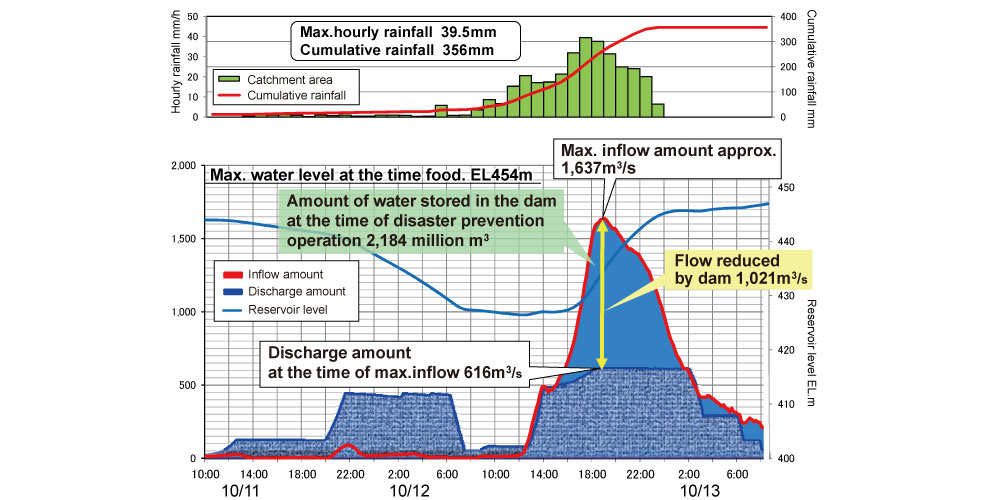
Record: Disaster prevention operation at the Kusaki (Typhoon No.19)
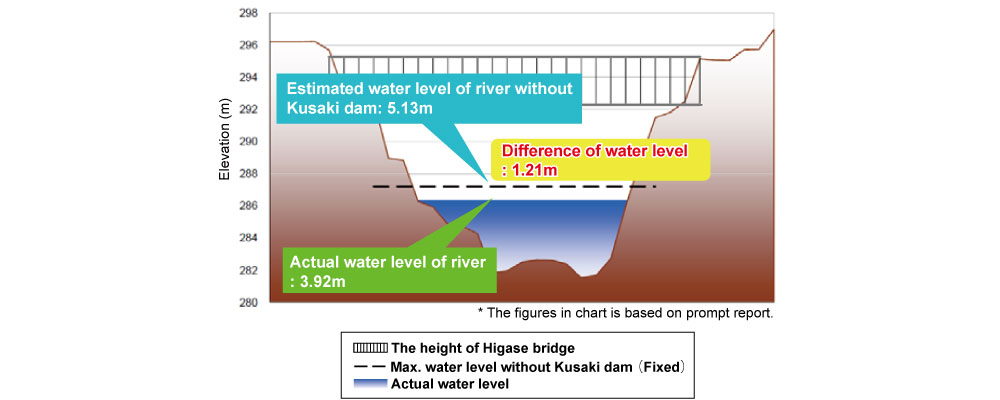
Hanawa point in the Watarase river 6km downstream
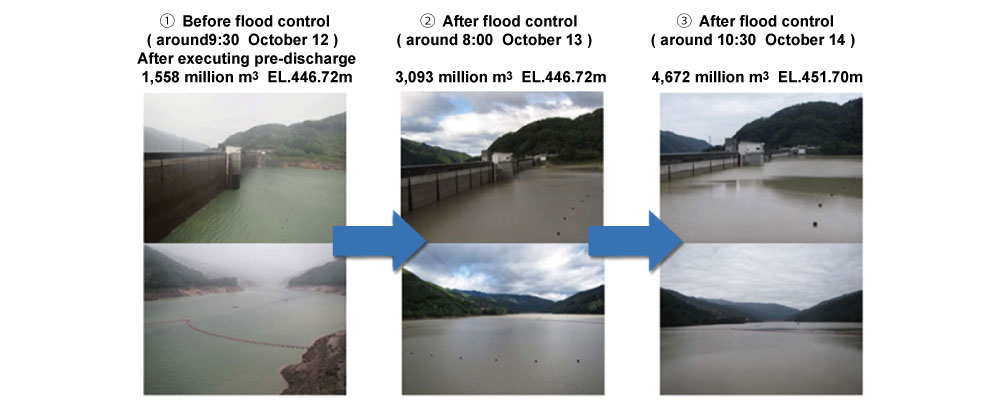
Comparison : before /after
Disaster support with drainage pumps
In response to a request from the relevant local governments, JWA dispatched trucks with drainage pump as below to actively contribute to recovery and reconstruction in the flood-damaged areas due to Typhoon No. 19.
Oyama City, Tochigi Prefecture
Upon receiving a request from Oyama City, Tochigi Prefecture, where was damaged from the flood caused by Typhoon No. 19, the JWA dispatched a pump truck on October 13 to the Nagano River and the Uzuma River. JWA conducted a drainage support operation near the confluence of the Uzuma River, around the Oshikiri area, Oyama City. As a result, water of approx. 36,000m³ was drained from 8:50 pm on October 13 through 6:00 pm on 14.
- Dispatched on
- October 13, 2019
- Started at
- At 8:50 pm, on October 13, 2019
- Completed at
- At 6:00 pm, on October 14, 2019
- Place
- Around Oshikiri area, Oyama City, Tochigi Prefecture
- Machinery
- A pump truck(Draining capability: 60m³ /minute)
*Deployed from the Tone Canal Management and Construction Office ( Gyoda City, Saitama Prefecture)
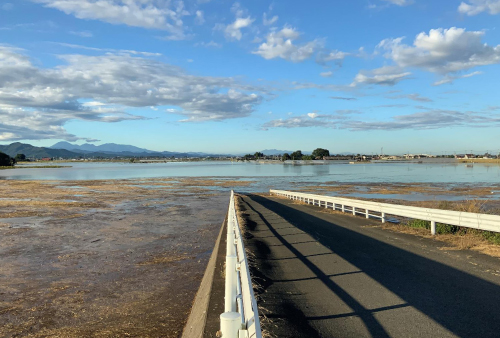
4:00 pm October 13
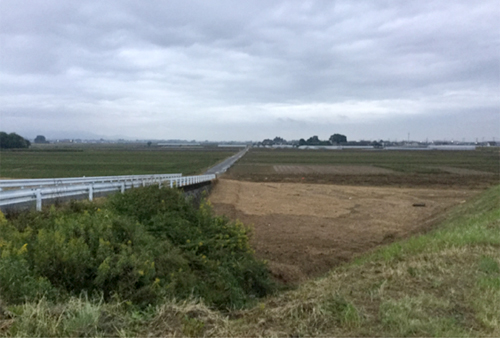
6:30 am October 15
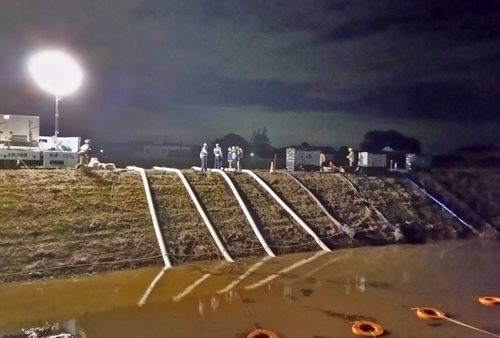
Start of work
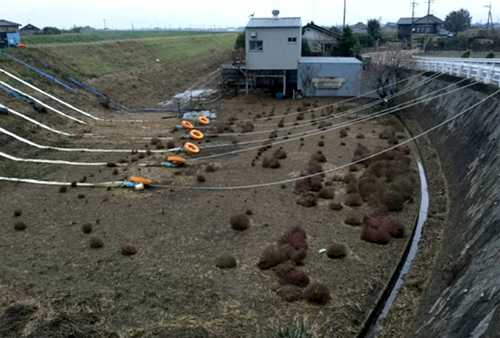
After the work
Gyoda City, Saitama Prefecture
Upon a request from Gyoda City, Saitama Prefecture, where was suffered by inundation due to Typhoon No. 19, the JWA dispatched a pump truck on October 13. JWA conducted a drainage operation for five hours from 3:20 pm on October 13 through 8:00 pm on 14.
- Dispatched on
- October 13, 2019
- Started at
- At 3:20 pm, on October 13, 2019
- Completed at
- At 6:00 pm, on October 13, 2019
- Place
- Around Midori-cho, Gyoda City, Saitama Prefecture
- Machinery
- A pump truck(Draining capability: 10m³ /minute)Deployed at the Tone Canal Management and Construction Office (Gyoda City, Saitama Prefecture)
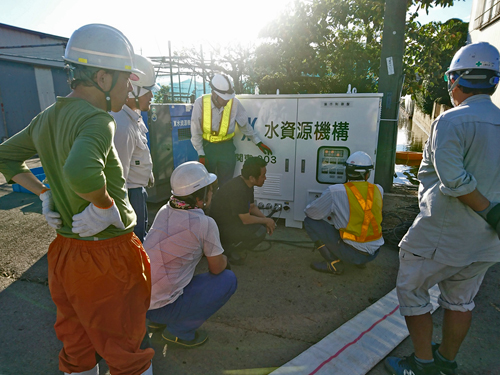
Installation of the pump package
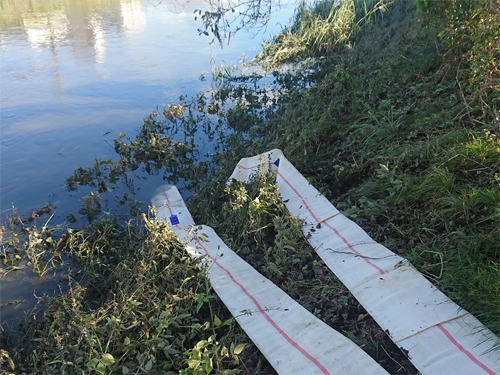
Drainage work















